Beppu Onsen
Beppu Onsen (別府温泉) is a group of hot springs in the city of Beppu, Ōita in Japan. Beppu Onsen is divided into eight major hot spring areas known as "Beppu Hatto".[1]
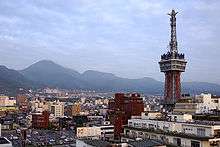
The most significant characteristic of Beppu's hot springs is the richness of its resources. The volume of water discharged is second only to that of the Yellowstone National Park in the United States.
There are 2,909 hot spring vents within the city, and these account for more than 10% of the 27,644 hot spring vents in Japan, according to a survey conducted by the Ministry of the Environment in 2004. Statistics from the Beppu City Hall show that more than 130,000 tons of hot spring water gushes from the ground every day. This is the second largest amount of hot spring water discharge in the world, and the largest amount in Japan.[2]
History
According to Iyo-no-Kuni Topography written in the beginning of the 8th century, once in the age of the gods, Sukunabikona (スクナビコナ) and Ōkuninushi visited Iyo-no-Kuni, now known as Ehime Prefecture. Sukunabikona fainted from illness. With a deep sorrow Ōkuninushi placed a long pipe at the bottom of the sea all the way through from Dōgo Onsen to Beppu to supply therapeutic thermal waters for him to bathe, by the grace of which he was saved. Also Bungo Topography tells about Akayusen (Chinoike Jigoku).
It is reported that in the Kamakura period Ōtomo Yoriyasu established some sanatoria in Beppu, Kannawa and Hamawaki to cure samurai wounded in the war against the Mongolian Army. From the Meiji period onward Beppu Onsen made great progress with the boring technique of Kazusa, in which more than 1000 wells were completed by the end of Meiji. In the 1960s and 1970s, after World War Two, Beppu Onsen made rapid development with social stability and economical revival. Especially from about 1919 to 1955, the amount of hot water taken rose to use the heat in agriculture and salt production, many problems happened; for example, the depletion of the old source of the springs and a decrease in temperature. Because of this, a new source of hot springs was searched and in 1957, a new layer of hot springs was found in 200m~300m below ground and was started for use.
Since 1964 using hot springs for salt production has been banned, however, using them for agriculture and aqua farming of fish has continued for the moment.
Hot spring areas
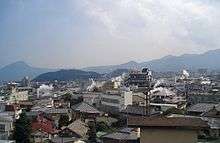

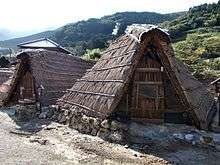
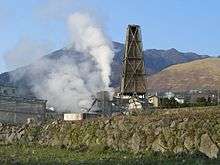
Beppu Onsen
Close to Beppu Station in the centre of town, Beppu Onsen is the most popular area. Ekimae-Kotō Onsen is a two-minute walk from the station and provides tired visitors and locals with invigoration and relaxation.
Kankaiji Onsen
Having the finest endowments of nature among the eight hot springs, this onsen site is located on a hill in the south-west urban area of Beppu. Bathers can enjoy medicinal hot spring waters along with spectacular scenery.
Kamegawa Onsen
This onsen area neighboring Kamegawa Station is much enjoyed for its rustic scenery. Beppu Kaihin Sunayu is known for its open-air sand bathing found near Beppu City's seashore.
Shibaseki Onsen
Located along a mountain stream, Shibaseki Onsen is a picturesque, quiet onsen area much noted for its hot steam bath. With a nice woodland trail, it is designated as a national health onsen resort.
Kannawa Onsen
With numerous jets of white steam emitting from gushing hot springs, this area is a must see destination for Beppu sightseers. Charming shops and Ryokan (Japanese inn) are tucked along the narrow and winding streets. It is also known for steam baths.
Myoban Onsen
Myoban Onsen, on the hill facing Beppu Bay, is a small, quiet mountain resort. Visitors enjoy several types of thermals such as mud bath or milky water bath accompanied by a distinctive sulphuric odor. Mineral deposits are worked at the thatched Yunohana-goya.
Horita Onsen
Located west of Kankaiji Onsen area, Horita Onsen is a rustic hot-spring resort. Appreciated since the Edo Period, its soothing waters relieve the fatigue of a long journey. The waters of two public baths work effectively on symptoms such as nerve pains.
Hamawaki Onsen
With quaint streets lined with old-fashioned inns and houses, Hamawaki Onsen is the birthplace of Beppu Onsen. Built in 1991, Yutopia (Utopia) Hamawaki, a multi-purpose health facility, is transforming the town's ancient flavour to a new, modern ambiance.
Public Baths
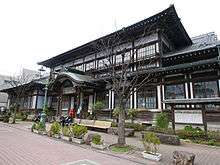
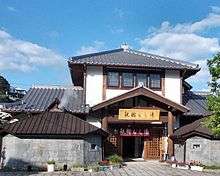
Takegawara Onsen
Originally built in 1879, "Takegawara Onsen" is located a short 7 minutes walk from Beppu Station. A fine bamboo thatched roof and elaborate facade is a proud symbol of Beppu Onsen. Particularly relaxing and fun are the sand baths, where attendants envelop appreciative guest's bodies in heaps of warm, soothing sand.
Kannawa Mushi-yu steam bath
A popular site in Kannawa Onsen mushi-yu steam bath has long served as a welcome facility for local citizens. "Ashimushi" (foot steam bath), a rarity in the country, is effective in relieving fatigued lower limbs. "Sekisho" (medical herb) room is also popular for its soothing aroma.
References
- https://enjoyonsen.city.beppu.oita.jp
- About Beppu - Beppu Navi Archived September 21, 2011, at the Wayback Machine
External links
| Wikimedia Commons has media related to Beppu Onsen. |